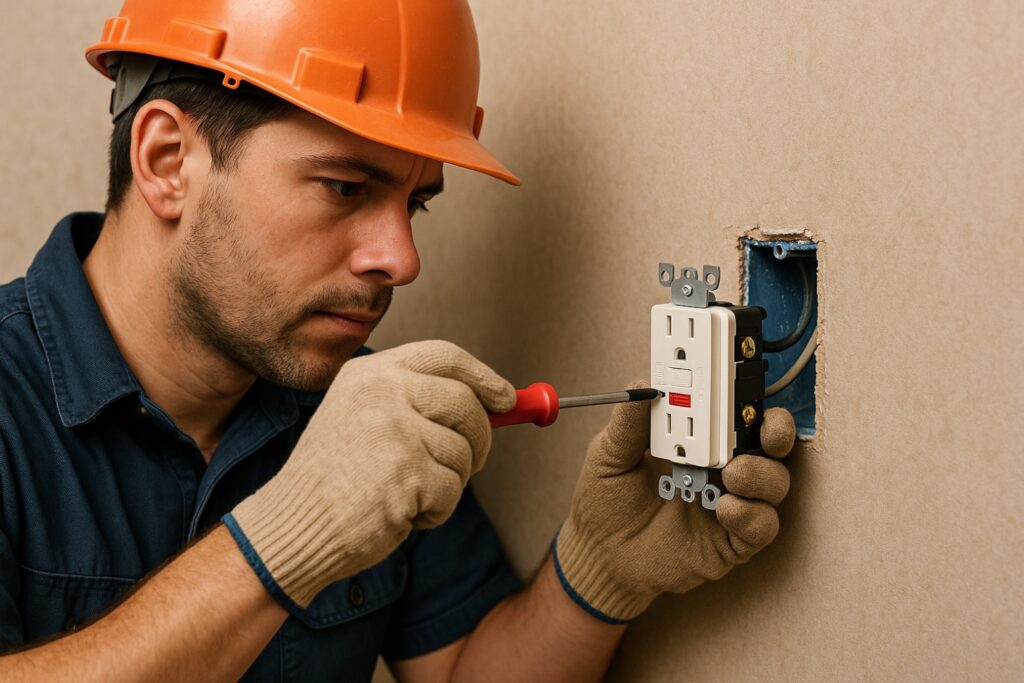Electricity is in every part of our daily lives. We rely on it to cook, to clean, to stay connected. But it’s not something to mess with. One small mistake—wet hands, a loose wire—and it can turn dangerous fast. That’s why GFCI outlets exist.
You’ve probably noticed them before. They look like regular outlets, but they’ve got two small buttons between the sockets—one says “test,” the other “reset.” These are GFCIs. Their job? To shut off power the moment something unusual happens. Simple idea, but it can save a life.
In this article, we’re going to break it all down: what a GFCI outlet is, how it works, and why you need them in certain spots around the house.
What is a GFCI Outlet?
GFCI stands for Ground Fault Circuit Interrupter. What it really means is that this outlet watches how electricity flows. It checks that power goes out and comes back the way it should.
Picture a loop. Power leaves on one wire (called “hot”) and comes back on another (called “neutral”). If something breaks that loop—say the electricity takes a different path, like through water or a person—that’s bad. The GFCI notices and shuts things down right away. We’re talking in a fraction of a second.
They’re especially useful in places where water is nearby. Water makes electricity even more risky, so that’s where these GFCI outlets matter most. For example, imagine you’re using a hairdryer and water splashes near the outlet. Or a plugged-in blender falls into the sink. The GFCI kicks in and kills the power. It doesn’t fix the mess, but it keeps you from getting hurt.
It’s not fancy. It’s not loud. But it does its job every time. It’s worth thinking about calling an electrician if your place is missing these in the right spots. It’s a small upgrade that could make a big difference.
Also Read: How to Convert a Light Switch to an Outlet?
Types of Electrical Outlets
Not every outlet in your home works the same way. Some are basic, while others are made for extra safety or special uses. Most homes have a mix of different outlet types. They depend on when the home was built or last updated.
1. Standard Outlets
These are the most common outlets. You’ll find them in:
- Bedrooms
- Living rooms
- Hallways
- Home offices
They usually have two or three holes — one for hot, one for neutral, and sometimes one for ground. These outlets do their job in dry spaces but don’t have built-in safety features. If there’s a short circuit, loose wiring, or a broken device, a regular outlet keeps running—it doesn’t shut off by itself. That’s one reason why standard outlets aren’t used near sinks or outside.
2. GFCI Outlets
A GFCI outlet is made to cut off power fast if there’s a problem. You’ll find them in areas like:
- Bathrooms
- Kitchens (especially near the sink)
- Laundry rooms
- Garages
- Basements
- Outdoors
They constantly watch the flow of electricity. If the current going out doesn’t match the one coming back, they shut off the power in less than a second. This quick response can stop shocks before they cause harm.
They also come with two buttons: “test” and “reset.” These help you check if the outlet is working and reset it if it trips. It’s a small safety feature that makes a big difference.
3. AFCI Outlets
AFCI stands for Arc-Fault Circuit Interrupter. These electrical installation services help prevent electrical fires.
They’re usually installed in:
- Bedrooms
- Living rooms
- Dining rooms
- Hallways
AFCIs react to sparks. So, if a wire is loose or damaged, it can lead to a fire. The AFCI sees this early and cuts off the power.
In many newer homes, building codes require AFCIs in most rooms. Some outlets today combine both GFCI and AFCI protection.
4. USB Outlets
USB outlets make charging easier. However, they’re built for convenience, not for electrical safety. They allow you to plug in different devices. This is all without using a separate charger. These are common in:
- Kitchens
- Bedrooms
- Living rooms
- Home offices
They save space and reduce clutter. Some USB outlets also feature smart charging. It adjusts the power flow based on the device plugged in. And while they’re handy, they don’t offer shock or fire protection like GFCIs or AFCIs.
Each outlet serves a different purpose. GFCIs protect against shock. AFCIs reduce fire risk. Standard outlets are fine for dry, low-risk spots. USB outlets make life easier when charging devices.
If you’re not sure which outlets are where in your home, take a few minutes to check. Look for the test and reset buttons to spot GFCIs. AFCIs are often labeled on your breaker panel or outlet cover. Knowing what you have helps you stay safe and plan for upgrades if needed.
How Does a GFCI Work?
A GFCI works on a simple idea, but it does something really important. Inside the outlet, there’s a tiny sensor that keeps an eye on the electricity going out and coming back in. It checks both all the time. If the numbers don’t match, something’s off.
Imagine you’re outside using a power tool, and it suddenly starts to rain. Water gets into the cord. Some of the electricity leaks out. The GFCI picks up on this—even a tiny amount, just a few milliamps—and shuts off the power.
It reacts in less than a blink—about 1/40 of a second. You might not notice, but that fast reaction can stop you from getting hurt.
These outlets also have a test and reset button on the front. You press the test button, and the outlet should turn off. Then, you press reset to bring the power back. If nothing happens during the test, it’s a sign the outlet isn’t working right and needs to be changed.
This built-in feature makes it easy for anyone to check their outlets. No tools, no big job. Just a quick press of a button now and then—it’s a small step that helps keep your home safe.
Why is a GFCI Outlet Crucial for Electrical Safety?
GFCI outlets protect people from electric shock. That’s their job — and they do it well, especially in places where water and electricity are close together. Bathrooms, kitchens, garages, and outdoor spots all carry a higher chance of accidents. GFCIs are built to stop the power before anything bad happens.
Think about everyday situations. A hairdryer falls into a sink full of water. A child plugs into a game console with wet hands. Someone uses a leaf blower after a rainy night. In each of these moments, a GFCI outlet can shut off the power in less than a second. That quick stop makes a big difference.
These outlets are not just smart — they’re fast. The U.S. Consumer Product Safety Commission says that hundreds of deaths from electric shocks happen every year. But since GFCIs became more common in homes, the number of fatal shocks in bathrooms has dropped by over 80%. That’s not just a number. That’s real lives saved.
Even a small shock can cause serious harm, especially to kids. Teaching young ones how to stay safe is just as important as using safe outlets. Here’s a helpful guide on electrical safety for children you can use at home. There are also real stories behind the statistics. In one case, a young boy in Florida avoided serious injury when a GFCI outlet tripped after he spilled water on a power strip in the bathroom. His family had only recently replaced the old outlet with a GFCI. That one change likely saved his life.
Electricity isn’t something we should fear, but it’s something we should respect. GFCI outlets help us do that. They’re small, simple, and reliable. And when they trip, it means they’re doing what they were made to do — keeping people safe.
When and Where to Install GFCI Outlets
Not every outlet needs to be a GFCI, but some places must have them. According to modern electrical codes, GFCI outlets are required in these spots:
- Bathrooms
- Kitchens (near sinks)
- Laundry areas
- Garages
- Crawl spaces and unfinished basements
- Outdoors (like on porches or patios)
- Anywhere within six feet of a water source
It’s a wonderful idea to update to GFCIs in the appropriate locations if you’re remodeling your house, adding a new room, or removing outdated outlets. Even in older homes, it’s smart to update your outlets. You don’t have to rewire the whole house — a licensed electrician can swap out the old outlet with a GFCI one in a few minutes. This small change can prevent big problems later.
If your breakers trip often or you’ve felt a shock when using an outlet, that could point to a bigger issue. A quick inspection can help reveal if you need electrical outlet repair.
Also Read: How Electricians Install a Kitchen Countertop Pop Up Electrical Outlet
How to Wire a GFCI Outlet
GFCI wiring might look easy, but it’s one of those things that needs to be done exactly right. If the wires are connected to the wrong terminals, the outlet might still work, but the safety feature won’t. That means you’d think you’re protected when you’re not.
This is one job where calling an electrician is worth it. They know how to do it safely and correctly. But if you’re curious, here’s what they usually do:
First, they shut off the power at the breaker. Then, they take out the old outlet and check the wiring. GFCI outlets have two sets of screws:
- one for the incoming power (labeled “line”)
- one for any other outlets connected to the same circuit (labeled “load”).
The wires—usually black (hot), white (neutral), and green or bare (ground). They need to go to the right spots. If anything is mixed up, the outlet might seem fine, but it won’t offer protection.
Once wired correctly, the outlet gets pushed back into place and tested using the built-in buttons. A certified electrician will also check for proper grounding and troubleshoot any GFCIs that trip too often. If they’re tripping because of moisture or a damaged appliance, they’ll help find the cause.
It’s not easy to notice wiring mistakes, and that makes the risk even bigger. When you’re dealing with safety, doing the job right matters more than getting it done fast.
Conclusion
GFCI outlets may look like any other plug on the wall. However, they do something powerful — they protect you and your family from electric shocks. That little button could be the thing that stops a serious accident from happening.
If your home doesn’t have GFCIs in these areas, it’s time to make a change. You can test the ones you already have by pressing the test button. And if anything looks worn out or doesn’t trip, get it checked.
Electrical safety isn’t about big changes — it’s about smart ones. And adding GFCIs is one of the smartest things you can do.






